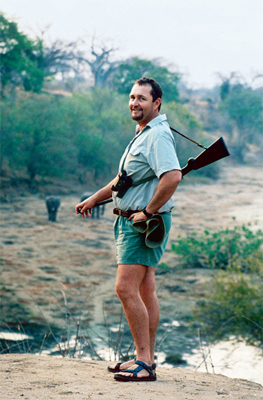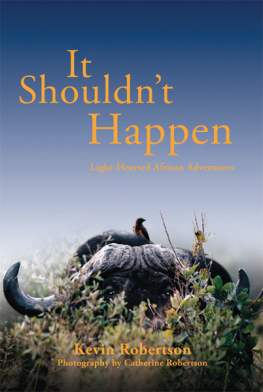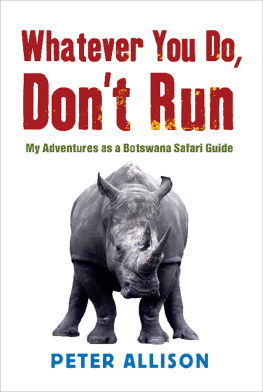

To Jen and Bill
For the second chance opportunities you have kindly given us.

To Our Readers
A day without laughter is like a day without sunshine.
Every African hunt or bush experience holds a story.
Not every hunt will be successfulbut it will, hopefully, provide some humor.
Combined, these statements provided the backbone and inspiration to this collection of short stories.
I hope you enjoy them.



Madonna
C harara Camp lies on the north bank of the river by the same name, some fifteen or so clicks upstream from where it enters Zimbabwes Lake Kariba. During the winter months of the hunting season, the riverbed appears dry, yet its waters flow steadily beneath its heavy golden sand. In several places throughout its length, usually on the outside corner of a sharp bend, this life-sustaining fluid rises to the surface to form small, naturally occurring, but often muddy water holes.
With little surface water available in the safari hunting area during the dry, hot months, these watering points sustain a constant stream of thirsty game animals. Charara Camp is conveniently situated between, and within view of, two such drinking places. As a result, it is a wildlife-lovers paradise and, for the sport hunter, the ideal starting point from which to track his quarry.
Elephant dominate these watering places, usually with much commotion, squealing and squabbling for the better part of most nights. Their attentions are most welcomeand beneficialbecause elephant have a habit of digging with their trunks and forefeet in a scattered, semicircular fashion, and into these freshly dug, football-size holes seeps beautifully cool, clean water. Having drunk their fill, the elephant depart, so silently that it seems one minute they are there and the next they are not.
The next to arrive are the dagga boys, old buffalo that are past breeding age and usually loners. They will normally come to take a drink in the predawn coolness so that they can get back to the scant shade and the relative protection the jess bush provides before it gets too hot. The bright morning hours see a continuous stream of dainty impala and their ever-vigilant and comical companions, the amazingly human baboon. At the hottest time of day, when the sun is directly overhead, the spiral-horned antelope speciesbushbuck, kudu, and the occasional elandcome to slake their thirst. In the afternoons it is the turn of the zebra and the warthogs, and toward evening, four species of doves arrive, flying in by the hundreds. At very last light, double-banded sand grouse jet in, announcing their impending arrival with electric-sounding Star Wars calls.
All concentrated within a few relatively small areas, this abundance of prey animals becomes easy pickings for Africas major predators: lion, leopard, hyena, and the painted hunting dog. Prey and predator alike are attracted to these watering holes, and, consequently, they are all to be found within the vicinity of Charara Camp in impressive numbers.
Madonna was one of them. A mature lion, bold and arrogant, he was obviously the dominant male of the pride that controlled the area surrounding Charara Camp. Magnificent in size, power, and strength, this impressive creature sported a ridiculously short, tufted mane, which was as bright in hue as the brassiest bottle blond. It was this mane that earned him the nickname of Madonna.
My initial encounter with Madonna occurred as I approached Charara Camp for the first time. I was hot and tired. It was the last week of September, and, as usual for that time of the year in the low-lying Zambezi Valley, it was oven hot. I had been at the wheel of my safari vehicle virtually all day, for it had taken me that long, on a terrible road, to drive up part of the considerable shoreline of that most impressive stretch of water, Lake Kariba. I had traveled from the far side of the Omay Safari Area, where I had been on a freelance hunt, to the Charara Safari Area. There I was to join my wife, Catherine, our neighbor, his wife, and one other couple for a combined leopard and buffalo hunt.
The sun had already set as I drove down the south bank of the Charara River. A large pride of lionthere must have been at least a dozen of themwere spread out along the warm sand, lying right on and next to the track where it crossed the river. The pride, lionesses and cubs of varying ages, were reluctant to move, and they only deigned to do so when I was virtually on top of them, glaring at me in disgust for my lack of consideration as I rode by.
By now I could see the twinkling lights of the camp on the opposite side of the dry riverbed. It was only a couple of hundred paces or so downstream, and my mind was set on a long, cold Castle lager, which I knew would be in one of the camps gas-fired bottle coolers. I crossed the river, which at that point was about three hundred paces wide.
Elephant dominate the Charara Rivers watering holes.
The Chararas north bank is high and steep, and the track that leads out of the riverbed is difficult to negotiate. I was, therefore, most surprised to see, sitting right in the middle of that track halfway up the steepest part of the bank, a magnificent, blond-maned lion. Sphinx-like, he observed my approach with interest.
I stopped at the base of the bank, only meters away from him. Watching me intently, he remained where he was, obviously not about to move. After a good minute or two, the thought of that ice-cold beer got the better of me, so, putting the Land Cruiser into low gear, I started up the bank, gunning the engine so as to gain momentum and get purchase in the thick sand. Madonna only moved when the bull bars actually nudged him, and with a loud growl and a single bound, he was up and on top of the bank in an instant. Concealing himself behind a small bush, he then lay glaring at me with his massive canines bared in a crinkle-lipped snarl.
The Masai herdsmen in Kenya, who know much about such things, consider all lion to have different and contrasting characters. If this is so, Madonna, I was soon to discover, was surely the Mike Tyson of the lion world.
Charara Camp is, in itself, relatively small, with most of its cleared area being dominated by two large evergreen trees. One of these is a Natal mahogany (Trichelia emetica), so big that it comfortably provided enough shade for the three tents that were pitched side by side beneath it. The other is a rain tree (Lonchocarpus capassa), beneath which our dining table was set. The rain tree was in full flower, carpeting most of the campsite with small, delicate, sweet-smelling, purple flowers.




















